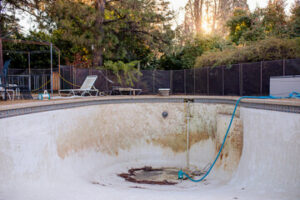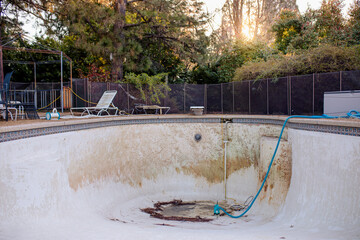Pool Resurfacing is a long-term investment that adds intrinsic and real value to your home. It will also help preserve your pool’s overall lifespan, making it more resilient against the effects of UV rays and chemicals.
Before beginning the resurfacing process, your swimming pool should be completely drained and free of debris. You should also hire a professional to sandblast the surface and chisel the underlying concrete.
When it comes to resurfacing a pool, the cost will vary depending on several factors. These include the size of the swimming pool and the finish type that you choose. In addition, you will need to consider any repairs that may be necessary before the resurfacing process begins. This can add up to a large bill, especially if the cracks in your pool are extensive. It is also important to consider the weather conditions when resurfacing your pool. Heavy rain can cause delays and increase the overall cost of the project.
Pool resurfacing is usually less expensive than replastering, which involves removing the old plaster and replacing it with new material. However, replastering is a good option for pools with severe damage or stains that cannot be covered with resurfacing. If you are looking for a more dramatic change to your pool’s appearance, you can also consider adding tile around the perimeter of the pool. This can add an aesthetic element to your pool, but it is usually the most expensive option for resurfacing a pool.
While the most common finish for a pool is plaster, there are many other options that you can choose from. You can even choose to add pigment to the plaster in gray, blue, or black hues for a custom look. Some of these finishes will last for up to 10 years, while others will need to be replaced sooner.
In addition to the finishing materials, you will need to consider the labor costs for your pool resurfacing project. While it is possible to resurface your pool yourself, it is recommended that you hire a professional to ensure the job is done correctly. Resurfacing a pool is a complicated task that requires specialized tools and knowledge that most homeowners do not have. In addition, resurfacing a pool can be dangerous if you are not familiar with the process.
While the cost of resurfacing your pool will vary, it is a worthwhile investment for those who want to extend the life of their existing swimming pool. It is also an excellent way to make your home more attractive and to boost its value.
Time
Whether your pool has been around for just a few years or decades, the natural elements and constant use can wreak havoc on its surface. Even a well-maintained pool can become stained and discolored over time, making it less than ideal for swimming and entertaining. But with professional resurfacing, you can make your pool look like new again without the cost and hassle of completely demolishing it and starting from scratch.
Before beginning the resurfacing process, you’ll need to drain your pool and clean it. While this may take several hours, it’s essential to ensure that any cracks are patched up and the water is free of rust stains or other minor instances of discoloration. This will also give you a chance to address any issues that are more serious, such as a slow leak.
Once the water is removed, you’ll need to sand down the pool’s existing plaster surface and apply a primer before you can begin painting. This step typically takes about four hours, but it’s crucial to the success of your project. Without the proper preparation, you’ll end up with a sloppy and uneven finish that can be difficult to repair down the line.
When it’s time to resurface your pool, it’s important to find a reliable and experienced company that can handle the job efficiently. You can do this by asking for personal recommendations from friends and family, or by searching online for reviews. Look for companies with positive ratings and good track records.
As with any major home improvement project, there are always unforeseen costs that pop up during the course of the work. If you’re not prepared for these expenses, they can quickly add up and increase your final bill. However, if you stay on top of your budget and avoid costly mistakes, you’ll be left with a beautiful new pool that you can enjoy for years to come. So if you’re tired of looking at your old and dingy swimming pool, don’t wait any longer—call a professional for help today! Enter your zip below and get matched with top-rated pros in your area.
Materials
If you have a pool that’s starting to show its age, resurfacing may be in order. Resurfacing your pool will restore its appearance and make it more safe for swimmers. It will also protect the pool’s structure and improve its functionality. There are many different types of resurfacing materials, so it’s important to know what your options are before you choose a product.
Concrete is one of the most durable resurfacing materials available and can withstand heavy wear. It’s also easy to repair and is inexpensive to install. However, it can crack over time and is susceptible to algae growth. If you choose concrete, be sure to choose a waterproof material for the liner.
Another popular resurfacing material is fiberglass, which comes in dozens of colors and designs. It’s also resistant to shifts in the ground and lasts for up to 10 years.
This type of resurfacing is usually more expensive than plaster, but it’s a great choice for pool owners who want to add value to their home. Fiberglass pools are also easier to maintain than concrete.
Epoxy is a common option for pool resurfacing, but it doesn’t hold up well against water exposure. If you’re thinking of resurfacing your pool with epoxy, you may need to do it again in two to five years. It’s important to consult a professional to ensure that you choose the right type of coating for your pool.
Regardless of which type of resurfacing you choose, it’s important to drain the pool before starting the process. This step will help prevent flooding and other complications. You’ll also need to scrub and pressure wash the surface of your pool. This will remove any dirt, debris and rust stains that could affect the outcome of your resurfacing project.
It’s best to do this during a period of low rainfall, but the exact timing will vary depending on your location and the weather. It’s also a good idea to choose a time when you won’t be using the pool. This will allow the resurfacing process to take place without disrupting your swimming schedule.
Expertise
If you are considering resurfacing your pool, it is best to hire professionals who have the right expertise for the job. This is a complex and labor-intensive process that can cost more than it should if it is done incorrectly. A professional will ensure the proper draining and will use the correct materials to get the best results. They will also be able to identify any underlying issues that need to be addressed before the resurfacing process begins. They will also be able to recommend the best options for your pool based on your budget and goals for the project.
There are many reasons for resurfacing your pool, including improved appearance and increased safety. Pool resurfacing also adds value to your property, which can help you sell it later on. It can be hard to determine the exact timeframe for resurfacing your pool, as it depends on the amount of wear and tear it endures each year and how often you use it. However, you can typically expect to resurface your pool every 10 years or so.
Before the resurfacing process begins, it is important to thoroughly clean the pool to remove any dirt, leaves or rust stains. It is also a good idea to pressure wash the surface of the pool to ensure that it is fully prepared for the resurfacing process. You may need to purchase a new liner as well, depending on the condition of your existing one.
After the surface of the pool has been cleaned, the resurfacing professional will apply several coats of plaster or cement, allowing each layer to dry between applications. This will provide a strong, smooth and durable finish to your swimming pool. Depending on the size of your pool, it can take a few days to complete the entire resurfacing process.
Once the resurfacing is completed, the professional will seal the pool and prepare it for use. This will include cleaning any areas of the pool that have been affected by water stains or algae. This will also include removing any old caulking around the tiles and making sure that all leaks are properly repaired.
